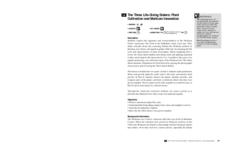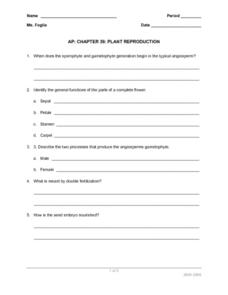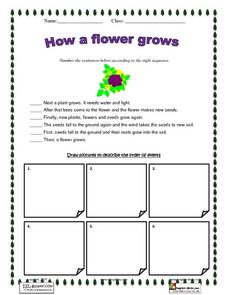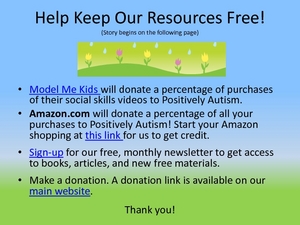Curated OER
Distinguishing Between Flowers
A branching key is a great way to classify different types of animals and plants! Fifth graders answer several yes/no answers about three different plants. They then create their own key to differentiate between an iris, a rose, and a...
The Science Spot
Flower Basics
Learn about plants and pollination with a worksheet about the parts of a flower. After labeling the anatomy of a flower using a word bank, kids explain the difference between self-pollination and cross-pollination, and unscramble...
Berkshire Museum
The Three Life-Giving Sisters: Plant Cultivation and Mohican Innovation
Children gain first-hand experience with Native American agriculture while investigating the life cycle of plants with this engaging experiment. Focusing on what the natives called the Three Sisters - corn, beans, and squash - young...
Curated OER
AP: Chapter 38: Plant Reproduction
Short, but sweet, this handout questions the learner on the structures and processes of plant reproduction. Budding botanists draw a dicot seed, label a flower diagram, and describe the functions of different flower parts. It also covers...
Cornell University
Weed IPM
Go on a weed hunt! Scholars gain insight into the characteristics of plants and examine the outdoor environment in order to identify five different types of weeds. Learners then show what they know with a one-page reflection.
Curated OER
Plants of Tyson Lagoon
In this aquatic plants and flowers worksheet, students identify and press 3 flowers from aquatic or marshy plants. They describe and identify the parts of the flowers in 2 short answer questions.
Biology Junction
Introduction to Plants
In this biology lesson, learners identify the different types and parts of the plant. They complete a crossword puzzle with 37 questions about plants.
Curated OER
What Parts of a Plant Do We Eat?
Did you know that tomtoes and cucumbers are actually fruits? Biology or botany beginners read about the function of flowers and fruit and find that some food items commonly called vegetables are, by definition, also fruits! Give learners...
Curated OER
Plant Parts
Little ones identify the parts of a plant and practice following directions at the same time. They color each part of the flowering plant the color indicated on the sheet. Roots are brown, leaves are green, the flower is red, and the...
Curated OER
How a Flower Grows
English Language Learners demonstrate their ability to sequence the steps in a process. After reading six sentences that describe how a flower grows, learners identify the right sequence and illustrate the steps. An answer key is provided.
Curated OER
Plant Groups
Compare different types of leaves in a science exploration. First, third graders identify common characteristics of various plants, such as daisies, fir needles, and cypress leaves. They then determine if the plants in each group are...
Curated OER
Identifying Variables
In this variables worksheet, students are given seven experiments that they read and identify the independent variable, dependent variable, control group and standardizing variable.
Curated OER
Plant Parts
In this identifying plant parts worksheet, students use a word bank to label the flower, stem, root, and leaf on an illustration of a plant and to fill in the blanks to complete sentences. Students write six short answers.
Curated OER
Mapping Gymnosperms and Angiosperms
In this plant worksheet, students create a map of a familiar area such as their yard, a nearby park, or the school grounds showing the major plants. On their map they identify the plants in three ways following the example provided. ...
Curated OER
Leaves
In this biology worksheet, students write identify the different parts of a leaf shown in 5 different diagrams. They also complete 12 short answer questions after reading the information about leaves.
Curated OER
Plant Parts And What They Do (5.2)
In this identifying plant parts and what they do activity, students answer multiple choice, true and false, and fill in the blanks with the best vocabulary words. Students write fifteen answers.
Curated OER
All About Seeds!
How do fruits relate to flowers and seeds? Identify the seeds and their purpose with a coloring activity for kindergartners. Once they color the seeds of apples, bananas, and peas (among others), kids get hands-on experience with bean...
Curated OER
Travis the Train: Spring Time Animals
Tag along with Travis the Train as he encounters various baby animals that live on the farm. The spring time story introduces special-needs or autistic children to the types of plants and animals found on farms, each animal is identified...
Curated OER
7.012 Genetics Section Problems
A set of phenotypes is listed for mice, flowers, blood type, and plants. For each, biology buffs analyze the percentages of phenotypes in the offspring and then identify the genotypes of the parents. This is a different approach to...
Wordpress
Darwin’s Natural Selection Case Studies
This editable worksheet is set up so that biology pupils read four case studies and identify points that are present in each, such as overproduction, heritable variation, struggle to survive, and differential reproduction. They also...
Curated OER
Explorit's Fruit Salad Quiz
In this online interactive plant quiz worksheet, students respond to 6 multiple choice questions that require them to identify the Latin names of plants.
Curated OER
Fungi and Plants
In this biology worksheet, students identify and locate various vocabulary terms pertaining to fungi and plants. There are 31 biology terms located in the word search.
Curated OER
Genetics Basics
In this basics of genetics worksheet, students review the concepts of genetic inheritance by writing the alleles for genetic traits inherited in offspring. They identify dominant and recessive traits given allele pairs, answer five...
Curated OER
The Young Virginia Gardener
In this recognizing plant problems worksheet, students read causes and effects of insects, diseases, watering, soil, and temperatures and identify problems in their gardens. Students list a maximum of four problems.























